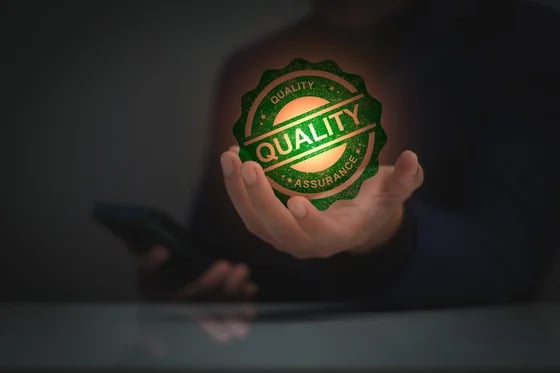The International Trade Blog Export Compliance
What Is a Certificate of Analysis?
On: December 11, 2023 | By:  Kari Crane |
4 min. read
Kari Crane |
4 min. read
 It’s not one of the most common export documents, but your foreign buyer may request a certificate of analysis (COA) to ensure the quality and safety of the product you’re exporting, especially for products in the pharmaceutical, food or chemical industries. Or, if you’re importing goods into the U.S., one may be required by the Food and Drug Administration (FDA) or another regulatory agency. A COA is a way to certify that products meet agreed-upon standards and to provide comprehensive information about the composition and quality of a product.
It’s not one of the most common export documents, but your foreign buyer may request a certificate of analysis (COA) to ensure the quality and safety of the product you’re exporting, especially for products in the pharmaceutical, food or chemical industries. Or, if you’re importing goods into the U.S., one may be required by the Food and Drug Administration (FDA) or another regulatory agency. A COA is a way to certify that products meet agreed-upon standards and to provide comprehensive information about the composition and quality of a product.
Often when a COA is required, it must accompany the shipment of the goods, and in some cases, a customer is not allowed to accept a delivery without the COA to confirm that a product meets certain specifications. In this article, we will explain more about a COA, including who needs it, how to create one, what information it should contain and the consequences of not using one.
Who Needs a Certificate of Analysis (COA)?
Regulations vary internationally, but generally, a broad spectrum of goods, from medicines and food to toys and heavy-duty machinery, may require a COA. The document will show that consumables are safe to consume (along with what the product is made of), and in the case of toys or machines, it will show that regulatory and safety requirements are met.
Manufacturers and distributors rely on them to verify the quality of their goods; regulatory agencies, such as the FDA or the European Medicines Agency (EMA), require them to show quality and safety standards are adhered to; and consumers benefit from them because they instill confidence regarding a product’s reliability.
How Do You Create a Certificate of Analysis?
According to the International Trade Administration, a COA “can be issued by a certification authority or by the exporter if the buyer agrees. Certificates of analysis may be obtained from an accredited laboratory.” Manufacturers submit final products or components to certified laboratories for testing. These are some of the steps that should be followed to improve accuracy:
- Sampling: Samples of the product are collected at various stages of production. These samples should be representative of the entire batch to ensure the COA accurately reflects the overall quality.
- Testing and Analysis: Rigorous testing and analysis are conducted on the collected samples. This may include physical, chemical and microbiological testing, depending on the nature of the product.
- Documentation: All test results and relevant information are documented in the COA. This documentation is crucial for providing a clear overview of the product's quality.
- Verification: The COA should be verified by qualified personnel, such as quality control experts or laboratory technicians, to confirm the accuracy of the information provided.
What Information Belongs on a Certificate of Analysis?
This is some of the information that is typically included on a COA (the FDA lists specific requirements here):
- Supplier: Contact information for the materials supplier.
- Materials: Lists the materials that are being verified, along with lot numbers, product codes and descriptions.
- Transportation: This section is provided to meet shipping requirements and confirm that the product is expected at the named destination. It will include the receiver’s name and destination, possibly the bill of lading number and any other transportation-related requirements.
- Conformance: Specifies the standards used for comparison during testing, ensuring that the product meets predetermined criteria.
- Signature: Includes the signature of an authorized individual, affirming the accuracy and validity of the COA.
What If You Don't Use a Certificate of Analysis?
Some may think it’s too costly to create a COA, but that can come with consequences:
- Both customers and consumers may lose trust in your brand.
- In industries with strict regulations, failure to comply may lead to fines, product recalls or legal action.
- When products are recalled or placed on hold, it will take longer to audit.
- Competitors who do provide a COA will have the edge.
More Documents You’ll Need for Your Exports
Using the right export forms is imperative for a seamless international sales process and ensures compliance with international regulations. The COA is just one of the documents you may need. To learn more about the most common export forms, download our free guide, The Beginner's Guide to Export Forms. And if you’re looking for a faster and easier way to create accurate export forms, register for a free demo of the software so we can show you how it works.
Like what you read? Join thousands of exporters and importers who subscribe to Passages: The International Trade Blog. You'll get the latest news and tips for exporters and importers delivered right to your inbox.

About the Author: Kari Crane
Kari Crane is the editor of Passages: The International Trade Blog. Kari joined Shipping Solutions after working as an editor, writer and designer at a major market newspaper in Texas. Kari has spent her career finding different ways to tell stories and make complex topics easy-to-understand, so she loves helping importers and exporters understand how to navigate the complex world of international trade.

